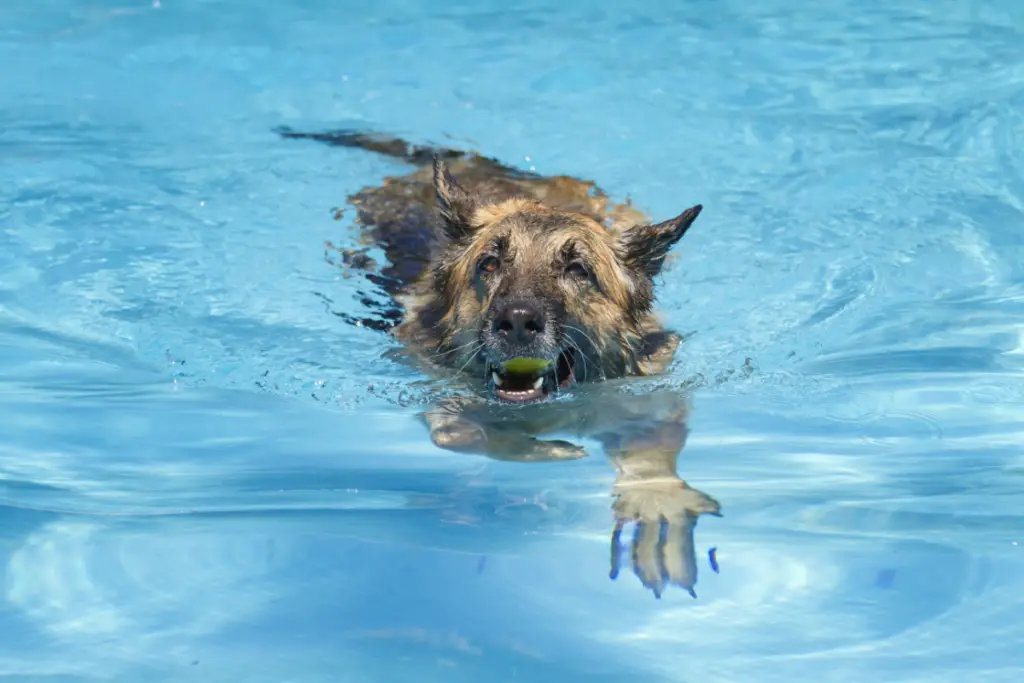Swimming is an excellent exercise for dogs, even senior dogs, and dogs who don’t have a full range of motion. But, you might be wondering: “How long should I let my dog swim to get a good amount of exercise?” The answer depends on several factors.
Dog breeds that are natural swimmers can swim for up to an hour without getting tired. However, for a German Shepherd, a good place to start is about 15–20 minutes if your dog isn’t trained to swim. It’s also important to put your dog in a life jacket to make swimming easier and less scary.
So what are the benefits of swimming for dogs? And how can you make the experience easy, fun, and rewarding for your dog? Read on to find out!

Is Swimming Good Exercise for Dogs?
Swimming can be a great source of exercise, relaxation, and even fun for your pooch. On the physical side, it engages the major muscles, stimulates blood circulation, and allows heavier dogs to move without straining their limbs.
On the mental side, if your dog feels safe while swimming, they should enjoy the soothing effect of the water, relax, and even have a little more fun than with other forms of exercise. It can also be a great bonding activity you can do with your dog.
How Long Is Enough?
Deciding how long to let your dog swim depends on their age, comfort in the water, as well as how in shape they are.
If you have a young puppy who’s just learning to swim, no matter what breed they are, it’s best to keep their swimming lessons short. About 5–10 minutes of swimming with a life jacket on should be enough at first. Then, if you notice your pup enjoying himself, you can push it a little longer.
A natural swimmer breed, like Labrador Retrievers or Portuguese Water Dogs, they can probably swim for a good while before they get tired. Shoot for something between 15–30 minutes at first, but they can easily go for longer if they want.
Other breeds will probably be okay with 15–20 minutes in the water at a time; just make sure your dog is trained to stay afloat and not ingest too much pool or seawater.
As for senior dogs and dogs with joint problems, they can swim for 10–15 minutes at a time. It’s crucial to have them wear a life jacket and be accompanied at all times. They should enjoy swimming, especially because it helps alleviate joint and muscle pain.
Swimming can also be great for overweight dogs who get tired easily when walking or running. Since water carries the weight of their bodies and provides some resistance without straining their joints, they’ll be able to exercise for longer and maybe lose some weight.
About 30 minutes of swimming daily should help an overweight dog snap back into shape in no time.
How to Help Your Dog Swim Better
Now that you know that swimming can benefit your dog tremendously, here’s a list of dos and don’ts that can make the experience better and more rewarding for you both!
Dos
1. Be in the Water at All Times
This is the number one piece of advice to take home from this: never leave a dog unaccompanied in the water. Dogs can get flustered and confused very easily, which in turn can lead to erratic movements that could make the dog swallow water or, even worse, drown.
You being in the water with your dog helps them feel at ease, so they’re less likely to get stressed. You can also direct the dog’s movements and prevent them from swimming too far into the sea or ocean if you’re in open waters.
2. Put a Life Jacket on Your Dog
Unlike the popular myth, not all dogs are natural swimmers. In fact, being in the water doesn’t feel natural to most dogs at first; even retriever breeds can have difficulty acclimating to the water.
A life jacket helps the dog feel safer because there’s something holding their weight, and they don’t have to paddle just to stay afloat. When a dog feels safe, they can start to engage all their four limbs in a swimming motion, which makes the exercise more efficient.
3. Pay Attention to Your Dog’s Reactions
Keeping a close eye on your dog’s reactions in the water can potentially save his life. If your dog seems stressed and ill at ease, take them out of the water immediately. They might have swallowed too much water or lost balance and are scared, and only you can figure that out.
Don’ts
1. Throw Your Dog in the Water
You might have heard this thrown around as advice to make your dog less afraid of the water, but it’s a pretty bad idea! Your dog will freak out if they feel the ground disappear beneath them, and it will take literal seconds for them to inhale water.
The same goes for making them chase a toy or another dog into the water if they’re inexperienced in swimming.
2. Leave the Dog Alone with Children
Children can’t provide a dog with enough safety in case something goes wrong, and a drowning dog might take a child down while trying to get out of the water.
Having at least one adult is essential for situations like this.
3. Swim in the Open Waters with No Leash
Lastly, avoid letting your dog swim with no leash in the ocean or in a lake because you never know where the current might take them.
Dogs can’t effectively swim against the current if they’re not good swimmers, and you shouldn’t rely on your ability to guide the dog with no leash in these cases.
Conclusion
How long should I let my German Shepherd Dog swim? Well, this depends on your dog’s age and physical condition, but keep it around 15–20 minutes at a time so your dog reaps the benefits of swimming without any of the downsides.
And remember, being around for your dog and putting a life jacket on to keep them safe is the most important thing you can do to avoid any unpleasant outcomes.
